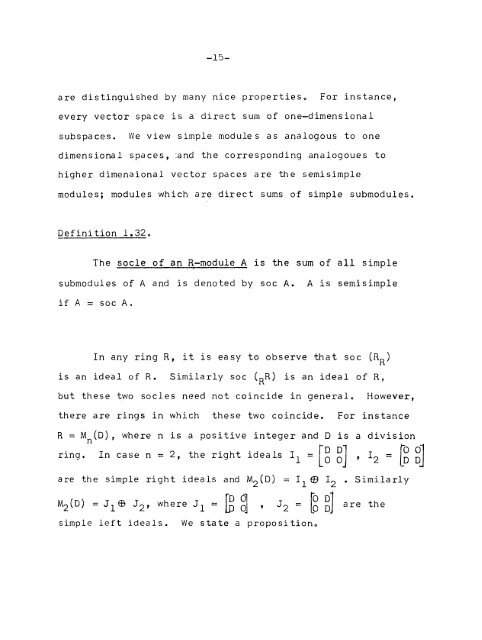Studies in Rings generalised Unique Factorisation Rings
Studies in Rings generalised Unique Factorisation Rings
Studies in Rings generalised Unique Factorisation Rings
You also want an ePaper? Increase the reach of your titles
YUMPU automatically turns print PDFs into web optimized ePapers that Google loves.
-15-<br />
are dist<strong>in</strong>guished by many nice propertieso<br />
For <strong>in</strong>stance,<br />
every vector space is a direct sum of one-dimensional<br />
subspaces. We view simple modules as analogous to one<br />
dimensional spaces, :and<br />
the correspond<strong>in</strong>g analogoues to<br />
higher dimenaional vector spaces are the semisimple<br />
modules; modules which are direct sums of simple submodules.<br />
Def<strong>in</strong>ition 1.32 0<br />
The<br />
socle of an R-module A is the sum of all simple<br />
submodules of A and is denoted by sac A. A is sernisimple<br />
i"f A = s oc A.<br />
In any r<strong>in</strong>g R, it is easy to observe that soc (RR)<br />
is an ideal of R. Similarly soc (RR) is an ideal of R,<br />
but these two socles need not co<strong>in</strong>cide <strong>in</strong> generalo However,<br />
there are r<strong>in</strong>gs <strong>in</strong> which these two co<strong>in</strong>cide. For <strong>in</strong>stance<br />
R = Mn(D),<br />
where n is a positive <strong>in</strong>teger and 0 is a division<br />
r<strong>in</strong>g. In case n = 2, the right idea Is 1 1<br />
= [g gJ 1 2<br />
= [g gJ<br />
are the simple right ideals and M 2(D)<br />
= 1 1<br />
fB 1 2<br />
• Similarly<br />
M 2 (D) = J l $ 3 2, where 3 1<br />
= m~ J 2 = [g g] are the<br />
simple left ideals. We state a propositiono
















